Pluto Moons and 5 Secrets of the Most Mysterious Dwarf Planet
30th May 2023
So far, we know very little about Pluto’s moons, especially since they appeared on star charts quite recently. The fact is that this dwarf planet is so small and so far from us that it is difficult to see it even with the most powerful telescope. What then can we say about Pluto moons, which are even smaller?
Humanity has managed to obtain some information about the Pluto system. We already know exactly how many moons Pluto has, what are their sizes, masses, and orbit parameters. We can analyse the way they formed and consider their impact on Pluto itself. This article will tell you about all this.
How many moons does Pluto have?
Today, astronomers are sure of five moons around Pluto. For comparison, all the terrestrial planets have only three in total. Not bad for a tiny planet like that, right? The moon that’s largest and closest to the planet is Charon, and it was discovered first.
Charon has four other smaller colleagues – Nix, Hydra, Kerberos and Styx. You can find pictures of Pluto and its moons on the official NASA website. One must say, this is a spectacular sight.
Why are the satellites of Pluto named like that?
By tradition, Pluto moon names are associated with the characters of ancient Greek mythology. Charon was the name of the carrier of souls to the realm of the dead, Nix was named after the Greek goddess of darkness and night, Hydra was named after the mythical nine-headed serpent, Styx is a river in the realm of the Dead, and Kerberos is the original Greek name for the famous dog Cerberus. But since the name Cerberus was previously assigned to an asteroid, it was decided to use the Greek transcription for the name of Pluto moon.
General facts about Pluto’s moons
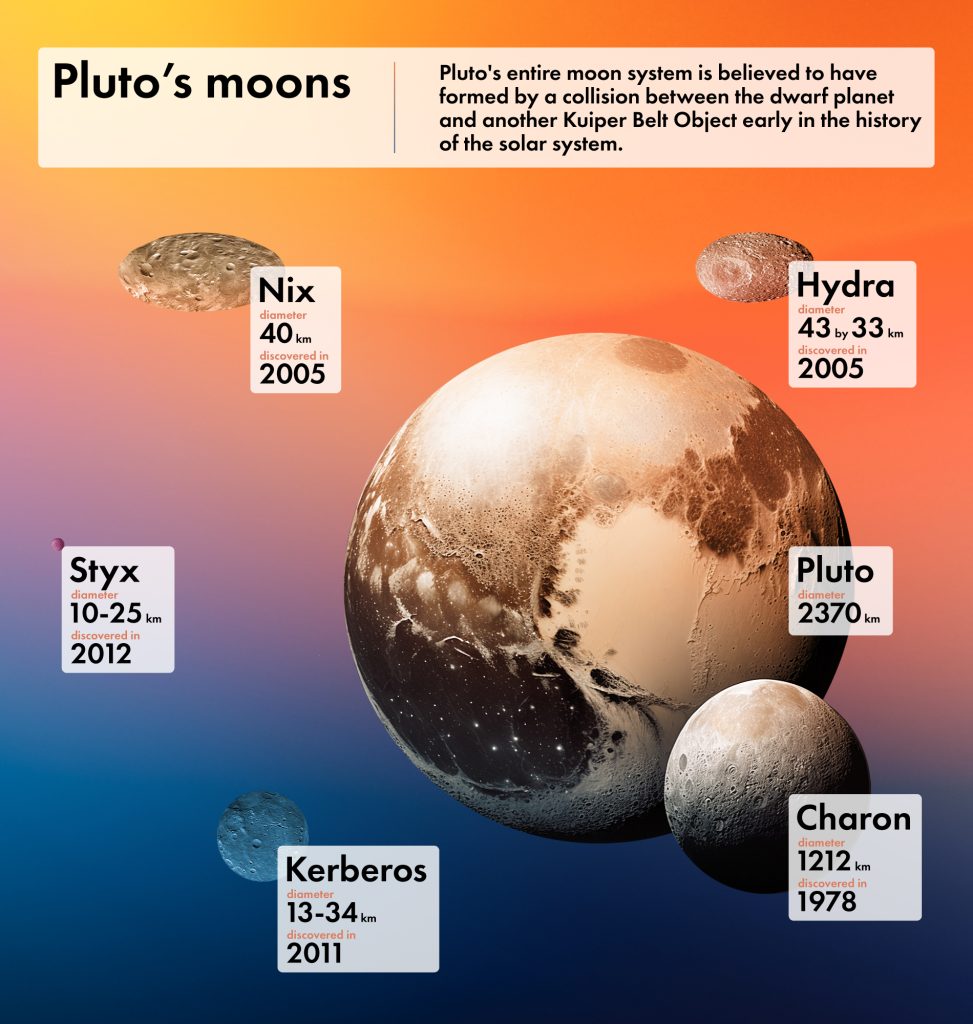
The entire satellite system of Pluto is believed to have formed as a result of the collision of two dwarf planets and another object from the Kuiper belt at the beginning of the solar system history. The collision ejected material, which coalesced into the family of moons observed around Pluto.
The moons of Pluto form a series of neatly nested orbits, a bit reminiscent of nesting dolls. Charon rotates synchronously with Pluto; that is, they always face each other on the same side, while the small moons do not: the period of their axial rotation is much less than the orbital one, and the rotation axes are strongly inclined to the axes of Pluto and Charon. Surprisingly, they all rotate at a tremendous speed, like spinning tops, which does not happen to any other planetary satellite in the solar system. The gravitational tides from Pluto should have slowed down and reoriented its moons’ rotation, but this is not happening. Scientists suggest that the cause may be collisions with other celestial bodies.
What is known about Pluto’s biggest moon, Charon
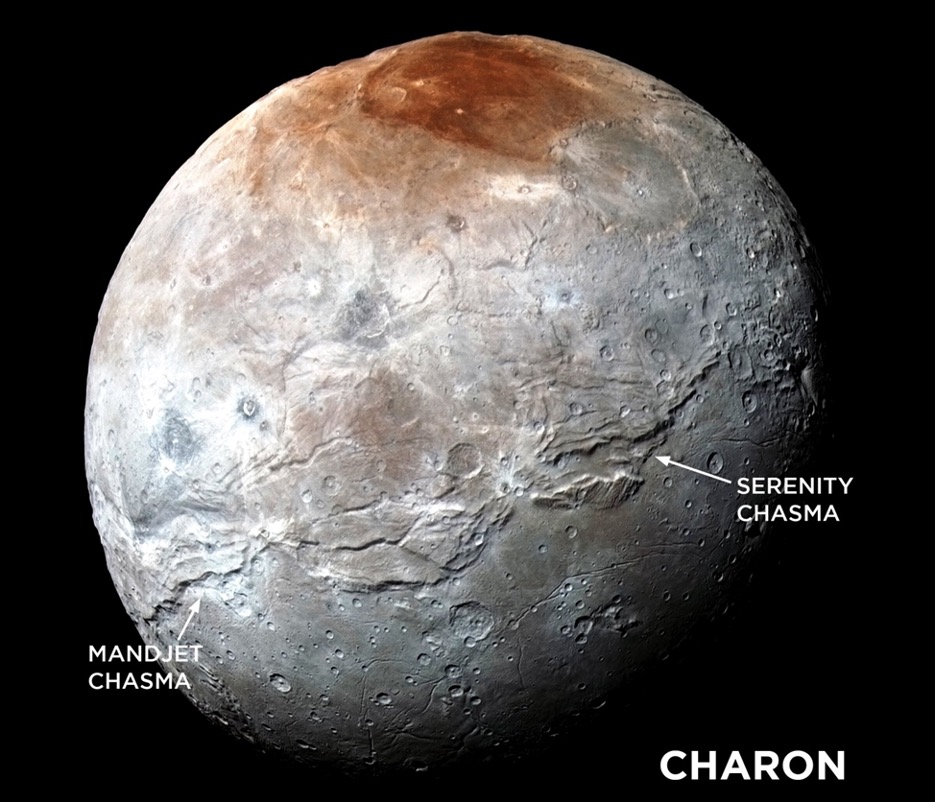
Due to the small angular distance between the moon and the planet, it is very difficult to observe it from the Earth. So, the discovery of Charon happened by chance. This honour belongs to the American scientist James Christie who, in 1978, managed to see the moon in a picture taken at the US Naval Observatory. The fact is that Pluto is a perfect sphere, but in the picture, it had a slightly oblong shape, while the stars that were in the same photograph were imprinted without distortion.
The main parameters of the moon were obtained during mutual eclipses and occultations, which are observed when the plane of Charon’s orbit passes near the line connecting the Sun and Pluto. Such events are repeated every 124 years. Photometric observations of the mutual passages of objects and their shadows across the disk of the planet and moon made it possible to determine the parameters most accurately.
Charon is half the diameter of Pluto (1207 km). At the same time, it is only 2.87 times smaller than the Moon (3,474 km), whereas the Earth is three times larger than Pluto!
Charon is almost twice as dark as Pluto and has a neutral grey colour. Its average density is 1.23 times lower since, unlike Pluto, covered with methane-nitrogen, Charon is covered by water ice. Scientists studied the source of cryovolcanic flows and ruptures and suggested that there was a liquid ocean under Charon’s surface that froze millions of years ago.
Interestingly, in 2017, the International Astronomical Union approved the order of naming objects on the surface of Charon in honour of science fiction and fantasy authors and fictional space characters. Thus, the mountains of Clark and Kubrick, the craters of Kirk, Spock, Uhura and Sulu (“Star Trek”), Darth Vader, Luke Skywalker and Princess Leia (Star Wars), Ripley Crater and Nostromo Canyon (“Aliens”), etc., appeared on Charon.
Facts about small Pluto’s moons
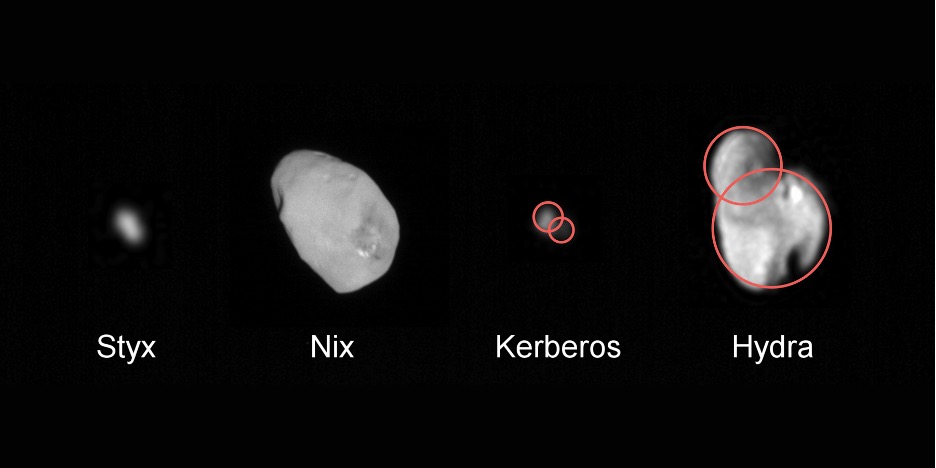
As soon as Charon was discovered, astronomers began looking for new moons orbiting Pluto, and soon discovered four more. Nix and Hydra were discovered in 2005 by Mike Brown and his colleagues at the California Institute of Technology using the Hubble telescope. To achieve this, long-exposure images were taken since the objects’ brightness turned out to be about five thousand times fainter than Pluto’s.
Niх
This moon has an elongated shape with dimensions of 54×41×36 km. The radius of the orbit is 49 thousand km; that is, it is two times farther from Pluto than Charon. Early studies showed that the surface of the moon has a reddish colour. Later ones show that Nix is spectrally neutral. This means that there is ice on its surface. Images taken by the New Horizons mission show a large reddish area of approximately 18 km. It is believed to be a large impact crater. Another explanation suggests that the reddish material came from a collision with an object that had a different composition.
The ice present on the moon’s surface contributes to its high reflectivity, as indicated by the images of Pluto and its moons. The period of axial tilt and rotation vary greatly over short time periods. Due to the chaotic rotation, Nix can flip its rotation axis.
Hydra
The moon has a size of 43×33 km and an orbit radius of 65,000 km. The surface is covered with relatively pure ice. This suggests that it is constantly being renewed by micrometeorite impacts pushing out darker material. Large craters suggest the moon has lost some of its original mass due to external influence. This is one of the most interesting facts about Pluto’s moons.
Kerberos
This moon was discovered in 2011 using the Hubble Wide Field Camera. Kerberos consists of two massive parts: one 8 km wide, the other one — 5 km wide. It could have formed after the collision of two small bodies. Researchers note the high reflectivity of the moon’s surface (albedo is about 0.5-0.6). Presumably, it is covered with relatively pure water ice.
At the time of discovery, the size of Kerberos was estimated at 13-40 km, but later, according to the images of the New Horizons device, a value of 12×4.5 km was obtained. The orbit of Kerberos lies between the orbits of Nix and Hydra. Its semi-major axis is approximately 58,000 km. The orbital period of the moon is 32 Earth days.
Styx
This is the smallest Pluto moon that was discovered in 2012 by Mark Showalter on nine images taken by the Hubble telescope in June-July 2012. Its size is 16×9×8 km, and in shape, it resembles an elongated oval. The composite image of Styx was obtained by the same New Horizons in 2015 when it was at a distance of 630,000 km from this moon.
Styx revolves around Pluto between the orbits of Charon and Nix. The semi-major axis of its orbit is 42,656(78) km. The period of revolution around Pluto is approximately 20 days. By the way, at first, they wanted to name this moon Vulcan, but since this name is not directly related to the realm of the dead, a decision was made in favour of the existing name to Styx.
Undiscovered moons of Pluto
Simulations of Pluto’s system, published in 2013, indicated that it could have about ten moons and one or more ring systems. However, these assumptions were not confirmed.
The New Horizons spacecraft did not detect a single new moon or a single ring. The fact that the spacecraft did not reveal anything new at close range, having much better opportunities for this than the Hubble telescope that discovered four Pluto’s moons, was a big surprise for astronomers.
And yet, let’s hope that new missions will allow us to learn more about Pluto and its system because space is full of mysteries, and we are opening the first pages of this fascinating book called The Universe.
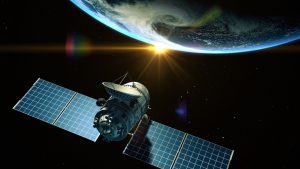

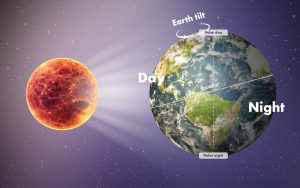



Thank you for your comment! It will be visible on the site after moderation.